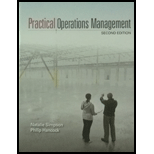
Concept explainers
Interpretation:
The EOQ and the EPQ recommend nearly identical order sizes, and its relationship with the concepts of instantaneous and no instantaneous relationships.
Concept Introduction:
The formula to calculate economic order quantity is
Explanation of Solution
Given information:
The given formula is,
It is a measure to determine the optimal order size of the inventory where the firm cannot replenish, it inventory instantly. In other words, the economic production quantity he evaluate the optimal order size when the inventory increase steadily after the order is place . this concept is applicable when the film produces its own inventory for consumption.
D refers to the annual demand
S refers to the annual fixed ordering cost
H refers to the annual holding costs of the inventory
P refers to the production rate inventory
d refers to the daily demand
Instantaneous replenishment:
It refers to the replenished of inventory immediately after the film places an order for the inventory. The economic order quantity assumes that the firm receives inventory immediate after it places the order.
Determine when the economic order quantity(EOQ) would be equal to economic production quantity(EPQ):
The economic order quantity assumes instantaneous replenishment and consider only the annul demand D order costs S and the holding cost H
On the other hand, the economic production quantity assumes non- instantaneous is replenishment and consider the ratio of daily production P to daily demand d
Conclusion:
Economic order quantity assumes that the replenishment of inventory is instantaneous. The economic production quantity consider the inventory non- instantaneous and hence, the rate daily production to daily demand. The economic order quantity will be equal to economic production quantity, if the daily demand or daily consumption of the order zero.
Want to see more full solutions like this?
Chapter 10 Solutions
Practical Operations Management
- The chapter presented various approaches for the control of inventory investment. Discuss three additional approaches not included that might involve supply chain managers.arrow_forwardUsing the same information, how do I: Determine the total inventory-related costs associated with the optimal ordering policy (do not include the cost of the coal). and If 5 days of lead time are required to receive an order of coal, how much coal should be on hand when an order is placed?arrow_forwardWhen cycle counting inventory, why do experts recommend a lower acceptable error tolerance for A items than B or C items?arrow_forward
- The Metropolitan Book Company purchases paper from the Atlantic Paper Company. Metropolitanproduces magazines and paperbacks that require 1,215,000 pounds of paper per year. Thecost per order for the company is $1,200; the cost of holding 1 pound of paper in inventory is$0.08 per year. Determine The economic order quantityarrow_forwardExplain the economic order quantity (EOQ) and its impact on cost of operations.arrow_forwardSaga ltd. produces electronic toys for children between the ages of 7-10 years old. The toys use a processor that is imported from Japan. Annual demand for the processor is 12,500. The holding cost per processor per year is $2. Ordering cost per order is $400. Lead time is 7 days and the number of working days in the year is 250. d. What is the optimal number of days between any two orders? e. What is the reorder point? f. Given the EOQ, what is the total annual inventory cost?arrow_forward
- Abey Kuruvilla, of Parkside Plumbing, uses 1,250 of a certain spare part that costs $26 for each order, with an annual holding cost of $27. a) Calculate the total cost for order sizes of 25, 40, 50, 60, and 100 (round your responses to two decimal places). b) What is the economic order quantity? units (round your response to two decimal places).arrow_forwardSaga ltd. produces electronic toys for children between the ages of 7-10 years old. The toys use a processor that is imported from Japan. Annual demand for the processor is 12,500. The holding cost per processor per year is $2. Ordering cost per order is $400. Lead time is 7 days and the number of working days in the year is 250. a. What is the economic order quantity? b. What is the optimal number of orders per year? c. Calculate the annual holding cost if the economic order quantity is used. d. What is the optimal number of days between any two orders? e. What is the reorder point? f. Given the EOQ, what is the total annual inventory cost?arrow_forward
 Purchasing and Supply Chain ManagementOperations ManagementISBN:9781285869681Author:Robert M. Monczka, Robert B. Handfield, Larry C. Giunipero, James L. PattersonPublisher:Cengage Learning
Purchasing and Supply Chain ManagementOperations ManagementISBN:9781285869681Author:Robert M. Monczka, Robert B. Handfield, Larry C. Giunipero, James L. PattersonPublisher:Cengage Learning
